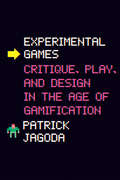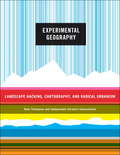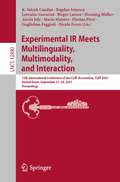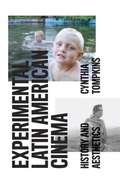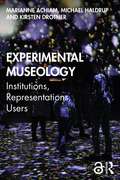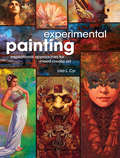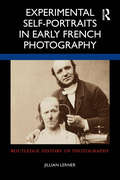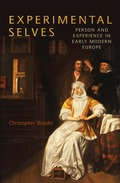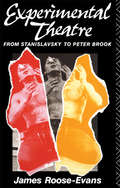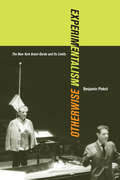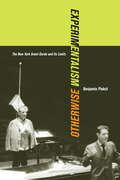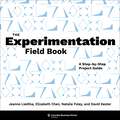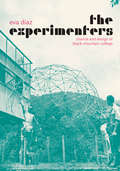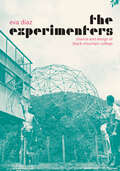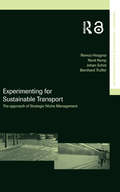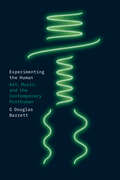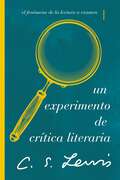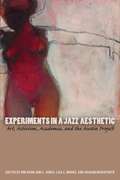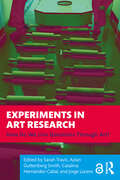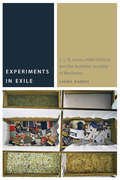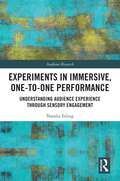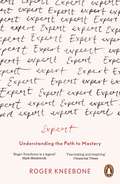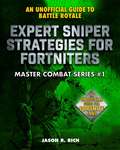- Table View
- List View
Experimental Games: Critique, Play, and Design in the Age of Gamification
by Patrick JagodaIn our unprecedentedly networked world, games have come to occupy an important space in many of our everyday lives. Digital games alone engage an estimated 2.5 billion people worldwide as of 2020, and other forms of gaming, such as board games, role playing, escape rooms, and puzzles, command an ever-expanding audience. At the same time, “gamification”—the application of game mechanics to traditionally nongame spheres, such as personal health and fitness, shopping, habit tracking, and more—has imposed unprecedented levels of competition, repetition, and quantification on daily life. Drawing from his own experience as a game designer, Patrick Jagoda argues that games need not be synonymous with gamification. He studies experimental games that intervene in the neoliberal project from the inside out, examining a broad variety of mainstream and independent games, including StarCraft, Candy Crush Saga, Stardew Valley, Dys4ia, Braid, and Undertale. Beyond a diagnosis of gamification, Jagoda imagines ways that games can be experimental—not only in the sense of problem solving, but also the more nuanced notion of problem making that embraces the complexities of our digital present. The result is a game-changing book on the sociopolitical potential of this form of mass entertainment.
Experimental Geography
by Nato Thompson Independent Curators International Jeffrey Kastner Trevor PaglenA photo of a secret CIA prison. A map designed to help visitors reach Malibu's notoriously inaccessible public beaches. Guidebooks to factories, prisons, and power plants in upstate New York. An artificial reef fabricated from 500 tons of industrial waste. These are some of the more than one hundred projects represented in Experimental Geography, a groundbreakingcollection of visual research and mapmaking from the past ten years.Experimental Geography explores the distinctions between geographical study and artistic experience of the earth, as well as the juncture where the two realms collide (and possibly make a new field altogether). This lavishly illustrated book features more than a dozen maps; artwork by Francis Alÿs, Alex Villar, and Yin Xiuzhen; and recent projects by The Center for Land Use Interpretation, the Raqs Media Collective, and the Center for Urban Pedagogy. The collection is framed by essays by bestselling author Trevor Paglen, Jeffrey Kastner, and editor Nato Thompson.
Experimental IR Meets Multilinguality, Multimodality, and Interaction: 12th International Conference of the CLEF Association, CLEF 2021, Virtual Event, September 21–24, 2021, Proceedings (Lecture Notes in Computer Science #12880)
by K. Selçuk Candan Bogdan Ionescu Lorraine Goeuriot Birger Larsen Henning Müller Alexis Joly Maria Maistro Florina Piroi Guglielmo Faggioli Nicola FerroThis book constitutes the refereed proceedings of the 12th International Conference of the CLEF Association, CLEF 2021, held virtually in September 2021.The conference has a clear focus on experimental information retrieval with special attention to the challenges of multimodality, multilinguality, and interactive search ranging from unstructured to semi structures and structured data. The 11 full papers presented in this volume were carefully reviewed and selected from 21 submissions. This year, the contributions addressed the following challenges: application of neural methods for entity recognition as well as misinformation detection in the health area, skills extraction in job-match databases, stock market prediction using financial news, and extraction of audio features for podcast retrieval. In addition to this, the volume presents 5 “best of the labs” papers which were reviewed as full paper submissions with the same review criteria. 12 lab overview papers were accepted and represent scientific challenges based on new data sets and real world problems in multimodal and multilingual information access.
Experimental Latin American Cinema: History and Aesthetics
by Cynthia TompkinsWhile there are numerous film studies that focus on one particular grouping of films—by nationality, by era, or by technique—here is the first single volume that incorporates all of the above, offering a broad overview of experimental Latin American film produced over the last twenty years. Analyzing seventeen recent films by eleven different filmmakers from Argentina, Brazil, Cuba, Mexico, Paraguay, and Peru, Cynthia Tompkins uses a comparative approach that finds commonalities among the disparate works in terms of their influences, aesthetics, and techniques. Tompkins introduces each film first in its sociohistorical context before summarizing it and then subverting its canonical interpretation. Pivotal to her close readings of the films and their convergences as a collective cinema is Tompkins’s application of Deleuzian film theory and the concept of the time-image as it pertains to the treatment of time and repetition. Tompkins also explores such topics as the theme of decolonization, the consistent use of montage, paratactically structured narratives, and the fusion of documentary conventions and neorealism with drama. An invaluable contribution to any dialogue on the avant-garde in general and to filmmaking both in and out of Latin America, Experimental Latin American Cinema is also a welcome and insightful addition to Latin American studies as a whole.
Experimental Museology: Institutions, Representations, Users
by Marianne AchiamExperimental Museology scrutinizes innovative endeavours to transform museum interactions with the world. Analysing cutting-edge cases from around the globe, the volume demonstrates how museums can design, apply and assess new modes of audience engagement and participation. Written by an interdisciplinary group of researchers and research-led professionals, the book argues that museum transformations must be focused on conceptualizing and documenting the everyday challenges and choices facing museums, especially in relation to wider social, political and economic ramifications. In order to illuminate the complexity of these challenges, the volume is structured into three related key dimensions of museum practice - namely institutions, representations and users. Each chapter is based on a curatorial design proposed and performed in collaboration between university-based academics and a museum. Taken together, the chapters provide insights into a diversity of geographical contexts, fields and museums, thus building a comprehensive and reflexive repository of design practices and formative experiments that can help strengthen future museum research and design. Experimental Museology will be of great value to academics and students in the fields of museum, gallery and heritage studies, as well as architecture, design, communication and cultural studies. It will also be of interest to museum professionals and anyone else who is interested in learning more about experimentation and design as resources in museums.
Experimental Painting: Inspirational Approaches for Mixed Media Art
by Lisa L. CyrWith page after page of stimulating possibilities, this book guides you on an uncompromising journey to visually dynamic, conceptually provocative, utterly original art. Embrace the spirit of creative play, break out of your comfort zone, and take your art to a whole new level. In her follow-up to the popular Art Revolution, Lisa L. Cyr delves deeper into an inspiring range of two and three-dimensional mixed-media techniques. Discover fresh, alternative ways to apply and manipulate painting media, transform surfaces, and create distinctive, message-driven work. Inside you'll find: A wide array of unconventional tools, materials and processes that help artists blaze their own unique and creative paths 12 step-by-step demonstrations highlighting specific experimental techniques, including freeform painting, making custom tools, and building dimension into a surface with inlaid boxes 3 feature demonstrations showing mixed-media processes at play in the creation of original artworks, from concept to completion A chapter on creative self-promotion revealing the latest marketing and presentation strategies for the working artist
Experimental Self-Portraits in Early French Photography (Routledge History of Photography)
by Jillian LernerThis book explores a range of experimental self-portraits made in France between 1840 and 1870, including remarkable images by Hippolyte Bayard, Nadar, Duchenne de Boulogne, and Countess de Castiglione. Adapting photography for different social purposes, each of these pioneers showcased their own body as a living artifact and iconic attraction. Jillian Lerner considers performative portraits that exhibit uncanny transformations of identity and embodiment. She highlights the tactical importance of photographic demonstrations, promotions, conversations, and the mongrel forms of montage, painted photographs, and captioned specimens. The author shows how photographic practices are mobilized in diverse cultural contexts and enmeshed with the histories of art, science, publicity, urban spectacle, and private life in nineteenth-century France. Tracing calculated and creative approaches to a new medium, this research also contributes to an archaeology of the present. It furnishes a prehistory of the “selfie” and offers historical perspectives on the forces that reshape human perception and social experience. This interdisciplinary study will appeal to readers interested in the history of photography, art, visual culture, and media studies.
Experimental Selves: Person and Experience in Early Modern Europe
by Christopher BraiderDrawing on the generous semantic range the term enjoyed in early modern usage, Experimental Selves argues that ‘person,’ as early moderns understood this concept, was an ‘experimental’ phenomenon—at once a given of experience and the self-conscious arena of that experience. Person so conceived was discovered to be a four-dimensional creature: a composite of mind or 'inner' personality; of the body and outward appearance; of social relationship; and of time. Through a series of case studies keyed to a wide variety of social and cultural contexts, including theatre, the early novel, the art of portraiture, pictorial experiments in vision and perception, theory of knowledge, and the new experimental science of the late-seventeenth and eighteenth centuries, the book examines the manifold shapes person assumed as an expression of the social, natural, and aesthetic ‘experiments’ or experiences to which it found itself subjected as a function of the mere contingent fact of just having them.
Experimental Theatre: From Stanislavsky to Peter Brook
by James Roose-Evans`It is a pleasure to read. Well-written, free of cant, impressively wide-ranging. The book is really an introduction to the avant-garde.' - John Lahr
Experimentalism Otherwise
by Benjamin PiekutIn Experimental Otherwise, Benjamin Piekut takes the reader into the heart of what we mean by "experimental" in avant-garde music. Focusing on one place and time--New York City, 1964--Piekut examines five disparate events: the New York Philharmonic's disastrous performance of John Cage's Atlas Eclipticalis; Henry Flynt's demonstrations against the downtown avant-garde; Charlotte Moorman's Avant Garde Festival; the founding of the Jazz Composers Guild; and the emergence of Iggy Pop. Drawing together a colorful array of personalities, Piekut argues that each of these examples points to a failure and marks a limit or boundary of canonical experimentalism. What emerges from these marginal moments is an accurate picture of the avant-garde, not as a style or genre, but as a network defined by disagreements, struggles, and exclusions.
Experimentalism Otherwise: The New York Avant-Garde and Its Limits (California Studies in 20th-Century Music)
by Benjamin PiekutIn Experimental Otherwise, Benjamin Piekut takes the reader into the heart of what we mean by "experimental" in avant-garde music. Focusing on one place and time—New York City, 1964—Piekut examines five disparate events: the New York Philharmonic’s disastrous performance of John Cage’s Atlas Eclipticalis; Henry Flynt’s demonstrations against the downtown avant-garde; Charlotte Moorman’s Avant Garde Festival; the founding of the Jazz Composers Guild; and the emergence of Iggy Pop. Drawing together a colorful array of personalities, Piekut argues that each of these examples points to a failure and marks a limit or boundary of canonical experimentalism. What emerges from these marginal moments is an accurate picture of the avant-garde, not as a style or genre, but as a network defined by disagreements, struggles, and exclusions.
The Experimentation Field Book: A Step-by-Step Project Guide
by Jeanne Liedtka Elizabeth Chen Natalie Foley David KesterExperimentation is an essential part of innovation. It is the link between generating new ideas and putting them into practice. We are constantly experimenting in our daily lives, and organizations place great value on testing new products, services, and strategies. Yet there is a shortage of actionable guidance on how to design and execute high-quality experiments for practical purposes.This book is a hands-on manual for crafting and conducting useful experiments in real-life settings. It guides readers from any background or discipline through the fundamentals of identifying testable ideas, selecting an evidence base, prototyping, and testing, building users’ skill sets and channeling their creativity through an interactive, exercise-oriented format. The book details a step-by-step framework, with user-friendly instructions and a case study illustrating the process at work at each step, as well as templates for readers to customize in their own projects. It draws on design thinking as well as other practical business approaches. From the classroom to the practice world, The Experimentation Field Book is a vital tool kit for all problem solvers and innovators seeking to address today’s pressing challenges.
The Experimenters: Chance and Design at Black Mountain College
by Eva DíazIn the years immediately following World War II, Black Mountain College, an unaccredited school in rural Appalachia, became a vital hub of cultural innovation. Practically every major artistic figure of the mid-twentieth century spent some time there: Merce Cunningham, Ray Johnson, Franz Kline, Willem and Elaine de Kooning, Robert Motherwell, Robert Rauschenberg, Dorothea Rockburne, Aaron Siskind, Cy Twombly--the list goes on and on. Yet scholars have tended to view these artists’ time at the College as little more than prologue, a step on their way to greatness. With The Experimenters, Eva Díaz reveals the importance of Black Mountain College--and especially of three key teachers, Josef Albers, John Cage, and R. Buckminster Fuller--to be much greater than that. Díaz’s focus is on experimentation. Albers, Cage, and Fuller, she shows, taught new models of art making that favored testing procedures rather than personal expression. These methodologies represented incipient directions for postwar art practice, elements of which would be sampled, and often wholly adopted, by Black Mountain students and subsequent practitioners. The resulting works, which interrelate art and life in a way that imbues these projects with crucial relevance, not only reconfigured the relationships among chance, order, and design--they helped redefine what artistic practice was, and could be, for future generations. Offering a bold, compelling new angle on some of the most widely studied creative figures of modern times, The Experimenters does nothing less than rewrite the story of art in the mid-twentieth century.
The Experimenters: Chance and Design at Black Mountain College
by Eva DíazIn the years immediately following World War II, Black Mountain College, an unaccredited school in rural Appalachia, became a vital hub of cultural innovation. Practically every major artistic figure of the mid-twentieth century spent some time there: Merce Cunningham, Ray Johnson, Franz Kline, Willem and Elaine de Kooning, Robert Motherwell, Robert Rauschenberg, Dorothea Rockburne, Aaron Siskind, Cy Twombly—the list goes on and on. Yet scholars have tended to view these artists’ time at the College as little more than prologue, a step on their way to greatness. With The Experimenters, Eva Díaz reveals the importance of Black Mountain College—and especially of three key teachers, Josef Albers, John Cage, and R. Buckminster Fuller—to be much greater than that. Díaz’s focus is on experimentation. Albers, Cage, and Fuller, she shows, taught new models of art making that favored testing procedures rather than personal expression. These methodologies represented incipient directions for postwar art practice, elements of which would be sampled, and often wholly adopted, by Black Mountain students and subsequent practitioners. The resulting works, which interrelate art and life in a way that imbues these projects with crucial relevance, not only reconfigured the relationships among chance, order, and design—they helped redefine what artistic practice was, and could be, for future generations. Offering a bold, compelling new angle on some of the most widely studied creative figures of modern times, The Experimenters does nothing less than rewrite the story of art in the mid-twentieth century.
Experimenting for Sustainable Transport: The Approach of Strategic Niche Management (Transport, Development and Sustainability Series)
by Johan Schot Remco Hoogma Rene Kemp Bernhard TrufferTechnological change is a central feature of modern societies and a powerful source for social change. There is an urgent task to direct these new technologies towards sustainability, but society lacks perspectives, instruments and policies to accomplish this. There is no blueprint for a sustainable future, and it is necessary to experiment with alternative paths that seem promising. Various new transport technologies promise to bring sustainability benefits. But as this book shows, important lessons are often overlooked because the experiments are not designed to challenge the basic assumptions about established patterns of transport choices. Learning how to organise the process of innovation implementation is essential if the maximum impact is to be achieved - it is here that strategic niche management offers new perspectives. The book uses a series of eight recent experiments with electric vehicles, carsharing schemes, bicycle pools and fleet management to illustrate the means by which technological change must be closely linked to social change if successful implementation is to take place. The basic divide between proponents of technological fixes and those in favour of behavioural change needs to be bridged, perhaps indicating a third way.
Experimenting the Human: Art, Music, and the Contemporary Posthuman
by G Douglas BarrettAn engaging argument about what experimental music can tell us about being human. In Experimenting the Human, G Douglas Barrett argues that experimental music speaks to the contemporary posthuman, a condition in which science and technology decenter human agency amid the uneven temporality of postwar global capitalism. Time moves forward for some during this period, while it seems to stand still or even move backward for others. Some say we’re already posthuman, while others endure the extended consequences of never having been considered fully human in the first place. Experimental music reflects on this state, Barrett contends, through its interdisciplinary involvements in postwar science, technology, and art movements. Rather than pursuing the human's beyond, experimental music addresses the social and technological conditions that support such a pursuit. Barrett locates this tendency of experimentalism throughout its historical entanglements with cybernetics, and in his intimate analysis of Alvin Lucier’s neurofeedback music, Pamela Z’s BodySynth performances, Nam June Paik’s musical robotics, Pauline Oliveros’s experiments with radio astronomy, and work by Laetitia Sonami, Yasunao Tone, and Jerry Hunt. Through a unique meeting of music studies, media theory, and art history, Experimenting the Human provides fresh insights into what it means to be human.
Experimenting the Human: Art, Music, and the Contemporary Posthuman
by G Douglas BarrettAn engaging argument about what experimental music can tell us about being human. In Experimenting the Human, G Douglas Barrett argues that experimental music speaks to the contemporary posthuman, a condition in which science and technology decenter human agency amid the uneven temporality of postwar global capitalism. Time moves forward for some during this period, while it seems to stand still or even move backward for others. Some say we’re already posthuman, while others endure the extended consequences of never having been considered fully human in the first place. Experimental music reflects on this state, Barrett contends, through its interdisciplinary involvements in postwar science, technology, and art movements. Rather than pursuing the human's beyond, experimental music addresses the social and technological conditions that support such a pursuit. Barrett locates this tendency of experimentalism throughout its historical entanglements with cybernetics, and in his intimate analysis of Alvin Lucier’s neurofeedback music, Pamela Z’s BodySynth performances, Nam June Paik’s musical robotics, Pauline Oliveros’s experiments with radio astronomy, and work by Laetitia Sonami, Yasunao Tone, and Jerry Hunt. Through a unique meeting of music studies, media theory, and art history, Experimenting the Human provides fresh insights into what it means to be human.
Experimenting the Human: Art, Music, and the Contemporary Posthuman
by G Douglas BarrettAn engaging argument about what experimental music can tell us about being human. In Experimenting the Human, G Douglas Barrett argues that experimental music speaks to the contemporary posthuman, a condition in which science and technology decenter human agency amid the uneven temporality of postwar global capitalism. Time moves forward for some during this period, while it seems to stand still or even move backward for others. Some say we’re already posthuman, while others endure the extended consequences of never having been considered fully human in the first place. Experimental music reflects on this state, Barrett contends, through its interdisciplinary involvements in postwar science, technology, and art movements. Rather than pursuing the human's beyond, experimental music addresses the social and technological conditions that support such a pursuit. Barrett locates this tendency of experimentalism throughout its historical entanglements with cybernetics, and in his intimate analysis of Alvin Lucier’s neurofeedback music, Pamela Z’s BodySynth performances, Nam June Paik’s musical robotics, Pauline Oliveros’s experiments with radio astronomy, and work by Laetitia Sonami, Yasunao Tone, and Jerry Hunt. Through a unique meeting of music studies, media theory, and art history, Experimenting the Human provides fresh insights into what it means to be human.
Un experimento de crítica literaria: El fenómeno de la lectura a examen
by C. S. LewisUn clásico de C. S. Lewis que nace de la convicción de que la literatura existe para el deleite del lector y que los libros deben ser juzgados por el tipo de lectura que invitan.Clive Lewis sostiene que la "buena lectura", al igual que la acción moral o la experiencia religiosa, implica la entrega a la obra en cuestión y un proceso de entrar de lleno en las opiniones de los demás: "al leer la gran literatura me convierto en mil hombres y sigo siendo yo mismo". Para su idea de juzgar la literatura es fundamental el compromiso de dejar de lado las expectativas y los valores ajenos a la obra, para acercarse a ella con una mente abierta.En medio de la compleja maraña de teorías críticas actuales, la sabiduría de C. S. Lewis es valiosamente realista, refrescante y estimulante en las cuestiones que plantea sobre la experiencia de la lectura en este clásico, Un experimento de crítica literaria.An Experiment in CriticismA C. S. Lewis's classic that springs from the conviction that literature exists for the joy of the reader and that book should be judged by the kind of reading they invite.Clive Lewis argues that "good reading," like moral action or religious experience, involves surrender to the work in hand and a process of entering fully into the opinions of others: "in reading great literature I become a thousand men and yet remain myself." Crucial to his notion of judging literature is a commitment to laying aside expectations and values extraneous to the work, to approach it with an open mind.Amid the complex welter of current critical theories, C. S. Lewis's wisdom is valuably down-to-earth, refreshing and stimulating in the questions it raises about the experience of reading.
Experiments in a Jazz Aesthetic
by Omi Osun Joni L. Jones Lisa L. Moore Sharon BridgforthIn Austin, Texas, in 2002, a group of artists, activists, and academics led by performance studies scholar Omi Osun Joni L. Jones formed the Austin Project (tAP), which meets annually in order to provide a space for women of colour and their allies to build relationships based on trust, creativity, and commitment to social justice by working together to write and perform work in the jazz aesthetic. Inspired by this experience, this book is both an anthology of new writing and a sourcebook for those who would like to use creative writing and performance to energize their artistic, scholarly, and activist practices. Theoretical and historical essays by Omi Osun Joni L. Jones describe and define the African American tradition of art-making known as the jazz aesthetic, and explain how her own work in this tradition inspired her to start tAP. Key artists in the tradition, from Bessie Award-winning choreographer Laurie Carlos and writer/performer Robbie McCauley to playwrights Daniel Alexander Jones and Carl Hancock Rux, worked with the women of tAP as mentors and teachers. This book brings together never-before-published, must-read materials by these nationally known artists and the transformative writing of tAP participants. A handbook for workshop leaders by Lambda Literary Award-winning writer Sharon Bridgforth, tAP's inaugural anchor artist, offers readers the tools for starting similar projects in their own communities. A full-length script of the 2005 tAP performance is an original documentation of the collaborative, breath-based, body work of the jazz aesthetic in theatre, and provides both a script for use by theatre artists and an invaluable documentation of a major transformative movement in contemporary performance.
Experiments in Art Research: How Do We Live Questions Through Art?
by Sarah Travis Jorge Lucero Azlan Guttenberg Smith Catalina Hernández-CabalExperiments in Art Research: How Do We Live Questions Through Art? is not a conventional research methods guide; it's an encounter for asking questions through art.Originating from the work of a community of tightly connected scholars, artists, and teachers, the book unfolds through a tapestry of moments, practices, and people, embracing the celebration of works in progress and in community. Rooted in the practice of permission-giving, the narrative intertwines personal stories—laying bare the transformative power of unconventional teaching methods, risky endeavors, and the breaking of scholarly norms—and begins by understanding that “art” and “research” are not separate. After that, there are endless directions to take up. Instead of a handbook offering rules or best practices, this text offers an inspiring collection of joy, longing, and determination.This is fascinating reading for arts-based researchers, artists, educators in the arts, education scholars, research-creators, performance theorists, art history scholars, art education scholars, inter- and anti-disciplinary scholars, qualitative and post-qualitative researchers, decolonization scholars, public humanities scholars, and writing pedagogy scholars.
Experiments in Exile: C. L. R. James, Hélio Oiticica, and the Aesthetic Sociality of Blackness (Commonalities)
by Laura HarrisComparing the radical aesthetic and social experiments undertaken by two exile intellectuals, Experiments in Exile charts a desire in their work to formulate alternative theories of citizenship, wherein common reception of popular cultural forms is linked to a potentially expanded, non-exclusive polity. <P><P>By carefully analyzing the materiality of the multiply-lined, multiply voiced writing of the “undocuments” that record these social experiments and relay their prophetic descriptions of and instructions for the new social worlds they wished to forge and inhabit, however, it argues that their projects ultimately challenge rather than seek to rehabilitate normative conceptions of citizens and polities as well as authors and artworks. <P><P>James and Oiticica’s experiments recall the insurgent sociality of “the motley crew” historians Peter Linebaugh and Marcus Rediker describe in The Many-Headed Hydra, their study of the trans-Atlantic, cross-gendered, multi-racial working class of the seventeenth and eighteenth centuries. Reading James’s and Oiticica’s projects against the grain of Linebaugh and Rediker’s inability to find evidence of that sociality’s persistence or futurity, it shows how James and Oiticica gravitate toward and seek to relay the ongoing renewal of dissident, dissonant social forms, which are for them always also aesthetic forms, in the barrack-yards of Port-of-Spain and the favelas of Rio de Janeiro, the assembly lines of Detroit and the streets of the New York. <P><P> The formal openness and performative multiplicity that manifests itself at the place where writing and organizing converge invokes that sociality and provokes its ongoing re-invention. Their writing extends a radical, collective Afro-diasporic intellectuality, an aesthetic sociality of blackness, where blackness is understood not as the eclipse, but the ongoing transformative conservation of the motley crew’s multi-raciality. <P><P> Blackness is further instantiated in the interracial and queer sexual relations, and in a new sexual metaphorics of production and reproduction, whose disruption and reconfiguration of gender structures the collaborations from which James’s and Oiticica’s undocuments emerge, orienting them towards new forms of social, aesthetic and intellectual life.
Experiments in Immersive, One-to-One Performance: Understanding Audience Experience through Sensory Engagement (Audience Research)
by Natalia EslingThis book investigates audience experience through the lens of sensory engagement in immersive, one-to-one performance. It presents a distinct, practice-based research (PBR) framework – a performance research ‘laboratory’ – designed to evaluate the effects on diverse audience experiences of two ‘sense-specific manipulations’: eye masks and touch. Through a qualitative analysis of responses from seventy-four individual audience participants, this book offers insight into how these popular ‘immersing’ strategies might be experienced. What do these strategies achieve? How do audience participants make sense of them? Do audience responses align with artistic intentions? And how does the PBR framework designed to address these questions influence the outcomes? Through an analysis of three sets of one-to-one performance experiments generating comparative data about the experience of sense-specific manipulation, this book proposes the utility of merging methodologies in artistic research with empirical audience research in theatre and performance studies. This study offers a new perspective on the value of sensory-focused, immersive, one-to-one experience as a means of resensitizing audience participants through performance.
Expert: Understanding the Path to Mastery
by Roger Kneebone'Roger Kneebone is a legend' Mark Miodownik, author of Stuff Matters'Fascinating and inspiring' Financial Times'The pandemic has made the necessity of relying on experts evident to all . . . this is a rich exploration of lifelong learning' GuardianWhat could a lacemaker have in common with vascular surgeons? A Savile Row tailor with molecular scientists? A fighter pilot with jazz musicians? At first glance, very little. But Roger Kneebone is the expert on experts, having spent a lifetime finding the connections.In Expert, he combines his own experiences as a doctor with insights from extraordinary people and cutting-edge research to map out the path we're all following - from 'doing time' as an Apprentice, to developing your 'voice' and taking on responsibility as a Journeyman, to finally becoming a Master and passing on your skills. As Kneebone shows, although each outcome is different, the journey is always the same. Whether you're developing a new career, studying a language, learning a musical instrument or simply becoming the person you want to be, this ground-breaking book reveals the path to mastery.
Expert Sniper Strategies for Fortniters: An Unofficial Guide to Battle Royale (Master Combat)
by Jason RichHit your target every time with this Fortnite expert sniper guide. This all‑new, unofficial, illustrated guide series will turn you into a master Fortnite: Battle Royale gamer by uncovering all the best strategies and secrets of this wildly popular game. Whether you play Fortnite Battle Royale on a PC, Mac, Xbox One, PlayStation 4, or your mobile device, you’ll find everything you need to stay at the top of your game. Each book is packed with useful insider tips on topics like, staying alive longer, exploring, collecting a powerful arsenal, building, and snagging more victories during each match. When it comes to achieving #1 Victory Royale, the Fortnite Battle Royale: Master Combat Series provides the ultimate competitive edge. Thanks to this comprehensive how‑to Fortnite shooting guide, you’ll gain the crucial battle skills you need to eliminate your enemies like a pro. Sniper rifles and projectile weapons are only as good as the player using them. This comprehensive resource will sharpen your skills and show you how and when to use the incredible range of guns, weapons, tools, and ammunition available during each match. There’s nothing more important in Fortnite than staying alive longer and battling your way to #1 Victory Royale. This straightforward guide has everything you need to prepare for long‑range, mid‑range, and close‑range combat situations so that you can emerge a winner.
